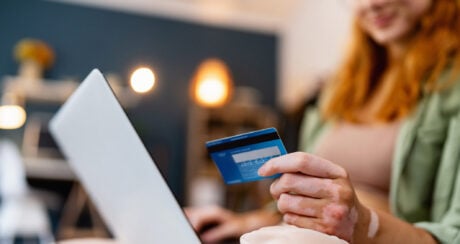Credit cards can be a convenient and flexible way to pay for things — as long as they’re used strategically. Every time you use your credit card, you tap into your pre-approved line of credit. So, with every purchase you make, you get further indebted to the bank. When you get your bill, you’ll need to cover your debt by making a credit card payment.
How do payments on a credit card work?
When you use your credit card, you’re spending borrowed money up to a pre-approved credit limit. As you continue making purchases, you start to amass more debt on your credit card balance. When you make a credit card payment, you repay what you owe, plus any accumulated interest and added fees.
You will generally pay after receiving your monthly credit card statement covering the most recent 30-day billing cycle, also called the statement period. The statement will show your balance and details about all the transactions that occurred within the period of that particular statement.
Your card issuer will send you a paper or digital statement, depending on your preference. Most banks should also automatically alert you of a new statement via online banking. Recent statements are available to download, and you should be able to access statements that are a year old or more by contacting your bank.
To avoid interest, you should try to repay your entire balance. Or, you can just pay the minimum amount on your statement or make a partial payment. For example, if you owe $1,000, you can either repay the entire $1,000, settle the minimum (which would be $20), or repay any amount in between.
Credit card payment options
When you make your payment, you’ll have a few options. You can:
- Make a minimum payment, which is the smallest amount you must pay.
- Make a partial payment, which means you’re paying off some of your balance.
- Repay your entire closing balance, which is the total amount owed on the card at the end of the most recent statement cycle.
Minimum payment
The minimum payment is calculated as a percentage of the closing balance. The bank sets this amount based on what you owe and is either approximately 2% of the outstanding debt or a flat dollar amount, usually $20.
Making minimum repayments is the easiest, least costly way to pay your credit card bill. The catch is, that by only paying the minimum amount due, you accumulate interest based on your credit card’s interest rate.
Pros
- You pay less now, so you can put your money toward other expenses or purchases.
- It keeps your account in good standing and avoids late fees.
- It helps you maintain momentum when building your credit report, as missed payments can harm your score.
- It’s an accessible option when you’re tight on cash and struggling to make a larger payment.
Cons
- It incurs interest, which means you’ll have to pay more than you borrowed.
- You could carry the debt for longer, which may be more difficult to pay off.
- It could take years — decades even — to get out of debt.
Partial payment
You can choose to pay anything between the minimum due and the full amount. There’s no right or wrong figure, but any extra amount you can put toward the outstanding debt is helpful. A few dollars can go a long way to reducing your total time over debt and the amount of interest you pay over a longer period. You can also make multiple partial payments.
Pros
- It helps you chip away at your debt and avoid late fees and penalties.
- It will lower your credit utilisation ratio, which can help your credit rating.
- It can show your credit card provider that you’re trying to repay as much as possible.
- You have more control over when you’ll repay the debt.
Cons
- You’ll still pay interest on the unpaid balance.
- You might not have extra funds to dedicate to other financial responsibilities.
Paying the full balance
Paying off your entire balance means repaying everything you owe while avoiding interest. If you can afford it, this is the best way to treat credit: using your card to make purchases that you plan to pay off completely by the due date.
Pros
- You’ll avoid paying interest on your balance.
- You’ll pay off debt faster.
- You save money in the long run, as you’re only repaying what you originally borrowed.
- You may help improve your credit rating.
Cons
- You may not have the money available to repay your entire balance.
- You might need to keep a lower credit limit to guarantee a full payment every 30 days.
How to make a credit card payment
There are plenty of ways to pay your credit card bill. Here are the most common methods:
- Online banking, preferably via the bank’s mobile app. Most credit card providers offer this option, and it is the most convenient way to make a payment.
- By phone or in person. Some people like to pay over the phone to speak to someone for additional support. You also can go to your local branch and settle the bill in person.
- By auto payment. You can set up autopay so you don’t have to rely on memory. Pick an account for the auto payment to come from every month. Just make sure that account doesn’t drop below a certain amount to avoid overdraft fees.
- By direct debit. If your credit card provider differs from your usual bank, you can set up a recurring direct debit. Check with your bank if the autopay can go straight to a credit card or if it needs to go via an everyday account.
How much should you repay?
You should aim to make frequent full repayments whenever possible. If you can pay off your credit card in full and it doesn’t affect your ability to pay your other bills, you should.
However, as long as you make the minimum payment, your bank will be happy. Remember, banks make money from credit cards. The longer you have one, especially with an outstanding balance, the more money banks make. Keep this in mind when reading your statements and making repayment decisions.
You can pay off your card whenever you like, and repayments are not subject to maximum limits. So, if you have an extra $50 or $100, you can make a voluntary credit card payment. Reducing your debt will go a long way toward your financial goals.
What if you can’t make a payment?
While it’s tempting to hide under a rock and wish away your credit card debt, being proactive is important if you find yourself in a bind. It may feel like it, but you’re not alone. Taking action and creating a repayment plan can help alleviate financial problems now and in the future.
Reach out to your bank first. There are people on the end of the line who help many Australians in your shoes. Discuss new terms for dealing with the debt and know exactly what you owe. Get emotional support from someone you trust and professionals like financial counsellors. The National Debt Helpline is a free, confidential practical and emotional support source.
DIVE EVEN DEEPER

9 Things To Know Before Getting Your First Credit Card
Understanding the basics can save you time, money and frustration and get you on your way to building good credit.

Pros and cons of using credit cards
Whether shopping in-store or online, know the pros and cons of using credit cards to benefit from fraud protection and other perks.

How to pay a credit card from another bank
Just because you can pay for a credit card from a separate bank account doesn’t mean it’s always the best choice. There are costs to consider.


